5 Easy Hacks to Manage Remote Teams
‘Groundhog Day’, ‘Contagion’, ‘The Twilight Zone’: These were just some of the many movies people mentioned that reminded them of the current situation.
At the time of writing this blogpost, the devastating human impact of this public health crisis is still evolving. Economically the most immediately painful consequences started to surface.
At NodeSource we are the lucky ones: As a ’distributed-by-design’ company we are largely operating like we always have. Many other companies are just getting used to working remotely. Yet, this change is often considered as a last resort.
This blogpost intends to help alleviate some of the anxieties associated with managing remote or distributed teams. It intends to provide some basic techniques and practices we found help us run a productive, engaged, healthy and motivated remote team. We hope they will help you and your teams do the same.
Why we love working remotely
NodeSource is a remote-by-design company. In the early days this meant that NodeSource could take advantage of the best Node.js talent, no matter where people were located.
When me and @dshaw started @NodeSource in 2014 we built the business to be "distributed by design" with potential health issues as a major factor behind our decision. https://t.co/7vwgcKguyb
— Joe McCann (@joemccann) March 2, 2020
Today, employee-health and happiness continue to be key drivers in retaining this model. Not only do we remain fully operational during a ‘shelter in place’ order, an important aspect of the decision to stay remote is employee happiness: the ability to swap rush-hour traffic for exercise, family time or creative endeavors.
Trust in breaking down the productivity Myth
‘This sounds great in theory, but how do you stay productive?!’
The fear of lost productivity often prevented companies from considering remote work arrangements in the past. Now that our collective reality has changed, the question remains.
What do we consider productive? Is productivity a metric measured by work output vs time or is it the actual value one creates for their company?
Invented during the industrial revolution, productivity was a metric referred to as output vs time: how many parts were you able to assemble, how many lines were you able to type in a given day etc. In the age of the knowledge worker, productivity is measured in ROI for the business, driven by teamwork, creative thinking, deals struck, partners secured, and plans executed.
In jobs where our hands are used to express complex thought, our main limitation is our ability to sustain focus on listening, analyzing, architecting and diagnosing. Distractions aside, your office environment has zero advantage over any other work-space when it comes to completing these tasks and achieving your goals.
Hard work is part of a team’s productivity equation, but so is health, exercise, healthy eating and the ability to recharge those creative batteries once emptied.

The latter is particularly important. The human brain is scientifically proven to only be able to focus on a singular task uninterrupted for about 20-50 minutes. Short bursts of distractions are built into our DNA.
Allowing your staff to work remotely has the added benefit that those minutes can now be spent in the comfort of their happy place – whether its a cup of tea in the yard, a quick game of fetch with their dog (or cat), a short yoga session after staring at code for 6 hours straight, or a private one-person dance-party to Tay Tay’s latest.
Yes, a boss may not be able to watch their employees work, but if that is the single determinant of your team’s success – the sad reality is: you won’t be managing for much longer. No one, neither the manager, nor the managed wants to work in an environment where that is required to see your team succeed.
At NodeSource intrinsic motivation and passion for Node.js drives a dedicated passion for evolving our product, which in turn nurtures self-discipline; a soft-skill I have found is readily available in disciplines where continuous learning is a pre-requisite for maximizing one's craft.
However, aligning one's self- discipline to a set work-schedule, independent of distractions constitutes a learned skill. Similar to any other skill it can be tested for during the hiring process, train and help nurture it across your team through process and tooling. You should check out this article by at arc.dev, a remote hiring agency, should you wish to learn more about this aspect.
At NodeSource the things that re-energize us are the aspects of life that help us bring our very best when it's game-time. As adults we understand that this is an arrangement that doesn’t need to be spelled out: We get to control how to be at our best in exchange for the trust our leadership team invests in us to bring our A-Game to every meeting, every brainstorm, every commit, test, document and presentation when our customers and the business needs it.
This trust is the foundation for how we structure remote work at NodeSource. As a Product Manager who worked with both remote and co-located teams, I can say with absolute confidence: It works!
I have never worked with a team that is so dedicated and showed such high and consistent velocity.
But so what: ‘Your team is awesome. Good for you. But how does this help me?’ you ask. Here are a few concrete hacks we found work for us at NodeSource. Whether they will work for you depends on your circumstances, but for us, they help us keep our customers, employees and stakeholders engaged, productive and happy.
A Note on This Pandemic
While the above reflects observations that were current before this abrupt change in our collective work reality, it is important to acknowledge the impacts this pandemic imposes especially on families. The techniques outlined in this blog post were found to be useful at times when childcare, homeschooling and a domestically shared workspaces weren’t something we were asked to accommodate for on our own.
This article by Chloe I. Cooney sums up those struggles quite nicely. ‘The Parents Are Not All Right’ makes the point that support for employees working from home against the backdrop of this novel context must exceed previous levels:
“There’s a subtle expectation that parents must find creative ways to handle this on their own. My in-box, social media feeds, and countertops are filled with creative ideas for educating and caring for your kids. I see these “helpful suggestions” alongside reminders to be gentle on ourselves. “Embrace imperfection!” “Lower your standards!” To be clear — my family’s standards at this point are simply to get through the day.” - Chloe I. Cooney
At NodeSource we have no proven recipe on how to adapt to this new situation. What has helped us is our leadership’s reaffirmed level of trust mentioned above. What matters more in any times of crisis, is a manager’s willingness and capacity to ‘walk the talk’. As the article mentions: actions must go beyond ‘embracing imperfection and positive affirmations.’
While the following hacks are designed to deliver more flexibility with the intent to let our team breathe, feel supported and empowered to be effective on their terms, they are no silver bullet for our current reality. It remains to be seen which practices will ultimately prove successful.
The hypothesis of this blog post is that ‘making the things you MUST do easier, allows for more things you CAN do to make work under this global pandemic better’. We hope that the following techniques will supplement your company’s strategic approach to this pandemic with some operational practices we feel worked for us.
1. Remote Sprints
At NodeSource our agile process is structured for remote efficiency. We are running weekly Sprints from Tuesday to Tuesday. Similar to the classical Sprint process we have two meetings, and two assets:
- Recorded Sprint Planning Proposal (Friday)
- Sprint Product Issues (Monday)
- Sprint Kick Off Meeting (Tuesday)
- Sprint Board (Tuesday – Monday)
1. Recorded Sprint Planning Proposal:

Yes we do have a green screen.
The Sprint Planning Proposal initiates the Sprint process. Every Friday, Product posts a video presentation covering:
(1) Progress made in the last Sprint per Epic
(2) Epics Product proposes should be progressed or completed in the next Sprint
This is a simple list covering Epic titles and their status only.
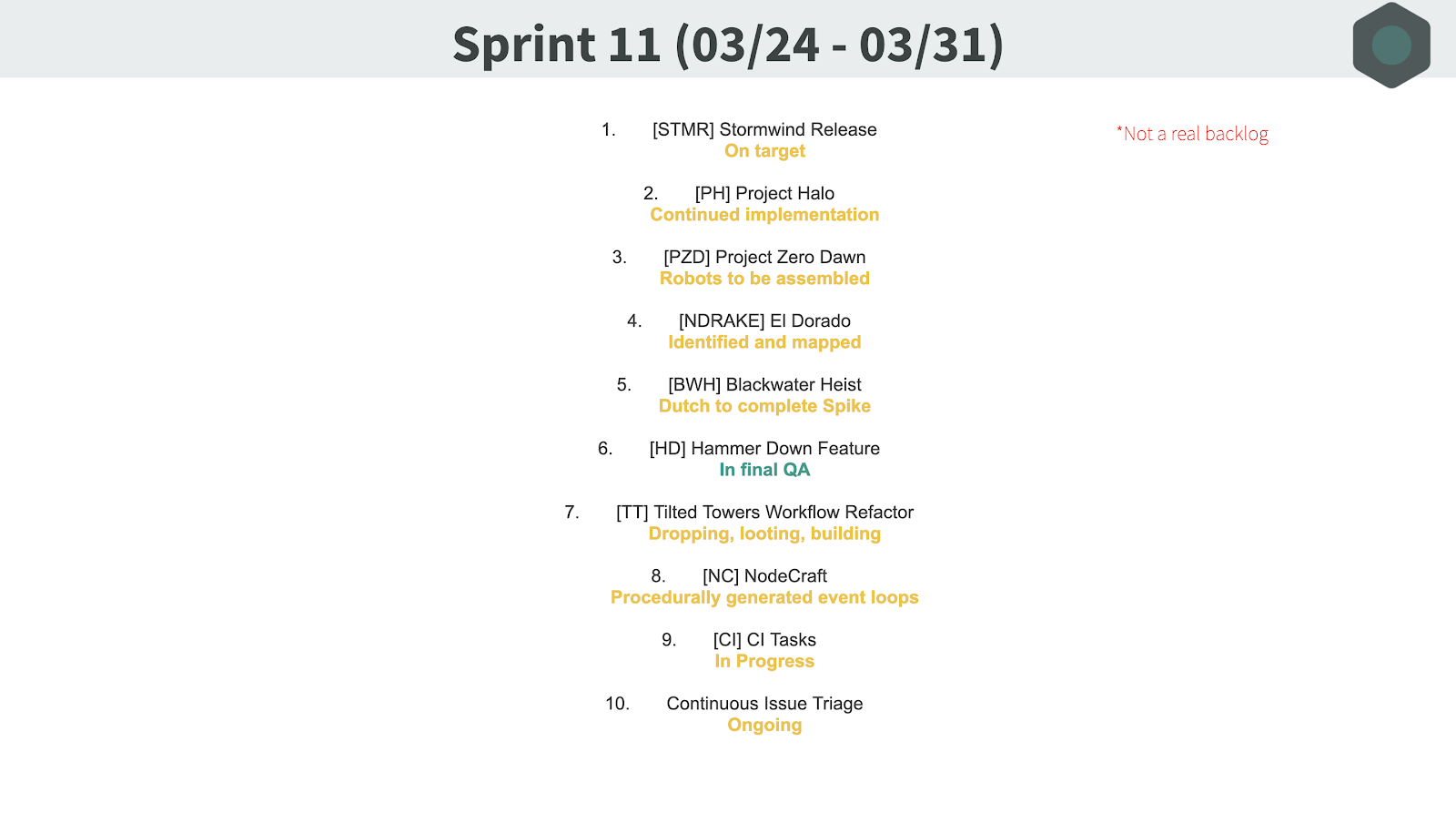
The video presentation helps the team mitigate the time they spend in meetings by delivering the following benefits:
- It can be played at 1.5x speed,
- It can be skipped forward and rewound,
- It also presents a permanent record for anyone who isn’t product or engineering (especially Senior Management).
2. Sprint Product Issues: Being Created on Monday
The aforementioned list of Epics is seen as a proposal. What Product wants, Product doesn’t always get: and that is ok! It is up to our subject-matter experts, our engineering team, to spend part of their Monday to groom their individual Sprint Backlogs. This means:
- Breaking down any new Epics introduced during the Sprint Planning Video into individual engineering issues or spikes
- Estimating each issue (spikes don’t get estimates)
- Populating their Sprint Backlog for the coming Sprint: this includes issues that were created from product epics, but also other issues left over as technical debt or bugs that popped up recently.

3. Sprint Kick Off The Sprint Kick Off meeting is the place where Engineering tells Product how much of the ‘proposed’ Epics can be addressed given the team’s current workload.
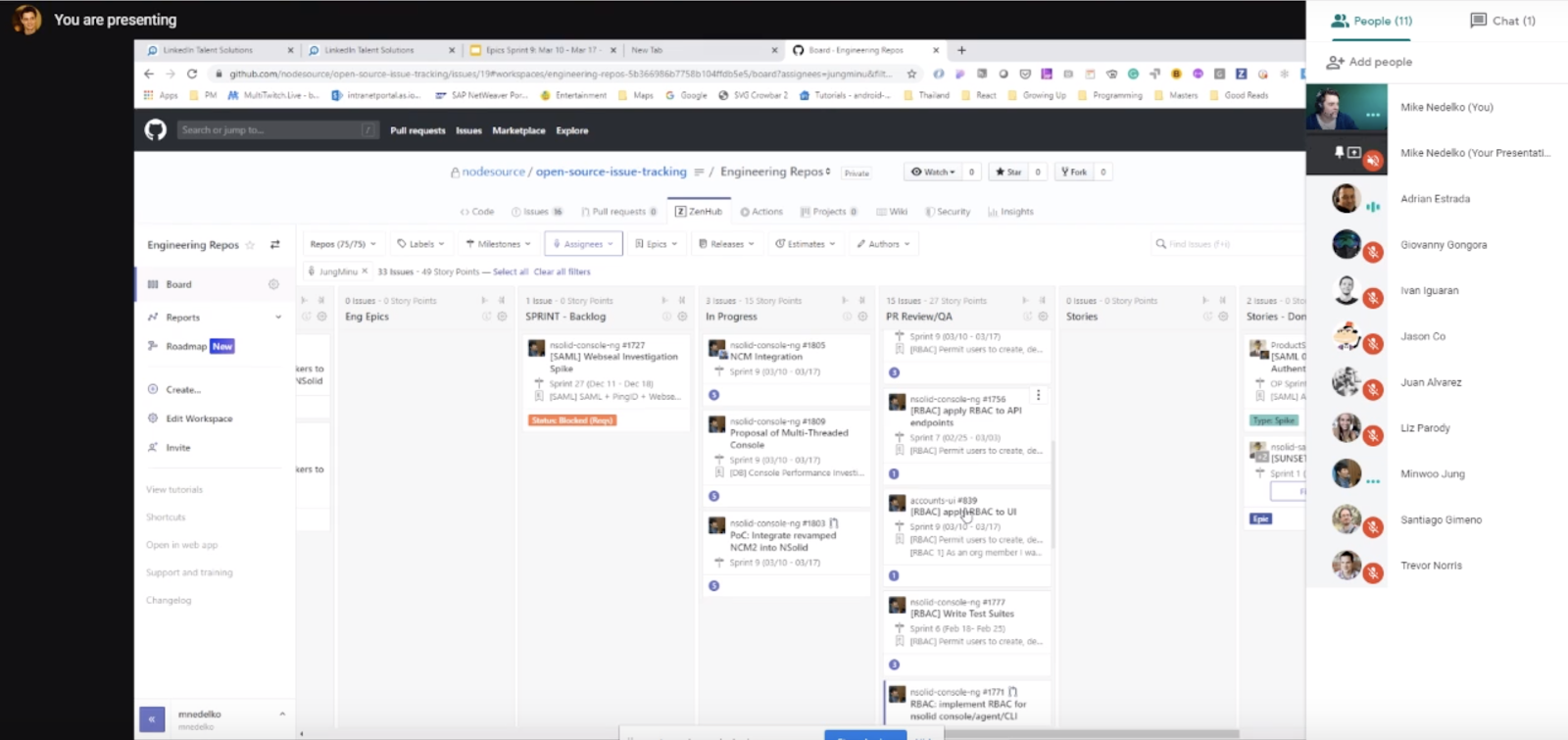
The Sprint Backlog pipeline can be considered as each Sprint’s to-do-list. Each team-member walks through the Sprint Backlog they created for themselves, the issues that remain in progress from the previous sprint and those that were completed.
At the end of the one-hour call, the team walks away with an updated ready-to-use engineering board, with which progress can be tracked and predicted based on the estimated issues the team intends to get done.
IMPORTANT: Instead of curating the Sprint Backlog as a team, each team-member comes prepared with a proposal. This maximizes the meeting’s efficiency. The trust dimension here is critical. To effectively deliver a feature, resolve issues and cure bugs, the company relies on each team-member to fill up their backlog for the entire week and sometimes even more.
At NodeSource this has proven to never be a problem: Our team’s dedication is rooted in a mutual understanding of the company’s overall product vision and why each individual’s contribution matters. We are driven in equal parts by the mission we pursue and the work-life balance a remote work-environment encourages, allowing us to be both dedicated and energized.
2. Record your meetings:
At NodeSource we don’t just record Sprint Proposals, we record and post any meeting that contains some sort of discussion or critical decision making.
Reason 1 – Facilitate Global Syncs:
There are a lot of talented individuals living in the Bay Area, but in an open source world, many of the most prolific and smartest individuals don’t; for good reason.
At NodeSource we are lucky to count some of the best talent in Node.js to our staff, calling in from Spain, South Korea, the United States, Latin Americas and India. Time zones can be a challenge, and while some of us are dedicated enough to jump on late at night or very early in the morning, that level of commitment consumes energy and should never be taken for granted.
Recording and posting team-meetings, updates and other calls, are helpful mediators to accommodate time zone commitments. Not only are videos a great way to catch up on pertinent conversation quickly, we even used them to record staff member’s contributions prior to certain meetings in order to show their updates during a pertinent call. This approach is highly dependent on the context of the meeting of course, but lends itself especially well to team huddles or weekly retrospectives of any kind.
Reason 2 – Your memory leaks
We have known since 1946, that as humans, we remember 70% of what we discuss with others, 50% of what we see and hear, 30% of what we see, 20% of what we hear and 10% of what we read within a 24hour window.
No-one can be expected to have perfect recall for every meeting they sit in, or go through copious amounts of notes. Fluctuations in concentration are normal. Recording your meetings is a valuable backup as long as all attendees consent. Ask your participants whether its ok to record, respect their responses, and if they agree, hit record and rest assured that no detail is lost.
Reason 3 – That POC you needed to Demo
‘Last month’s hackathon was great! Two teams hit it out of the park and presented fancy new integrations. Now the GitHub repo is out of date, the thing won’t run and a partnership call is scheduled for tomorrow.
What do you do?’
Call your engineers to spend an expensive day getting behind on the roadmap just to get it working for one meeting?
No.
You play the recorded video demo instead and verbally introduce the necessary disclaimers.
Whether it’s a POC, a workflow, or an idea that deserves revisiting, a video recording is capable of communicating ideas both visually and audibly, introducing the concept efficiently in a way that does previously accomplished work justice.
Recording Tools:
At NodeSource we use the completely free OBS, which comes with an easy to use recording feature and a Chroma Key filter if you want to do the green-screen thing for webinars, tutorials or presentation recordings. Other recording solutions like Zoom’s paid recording feature are also used.
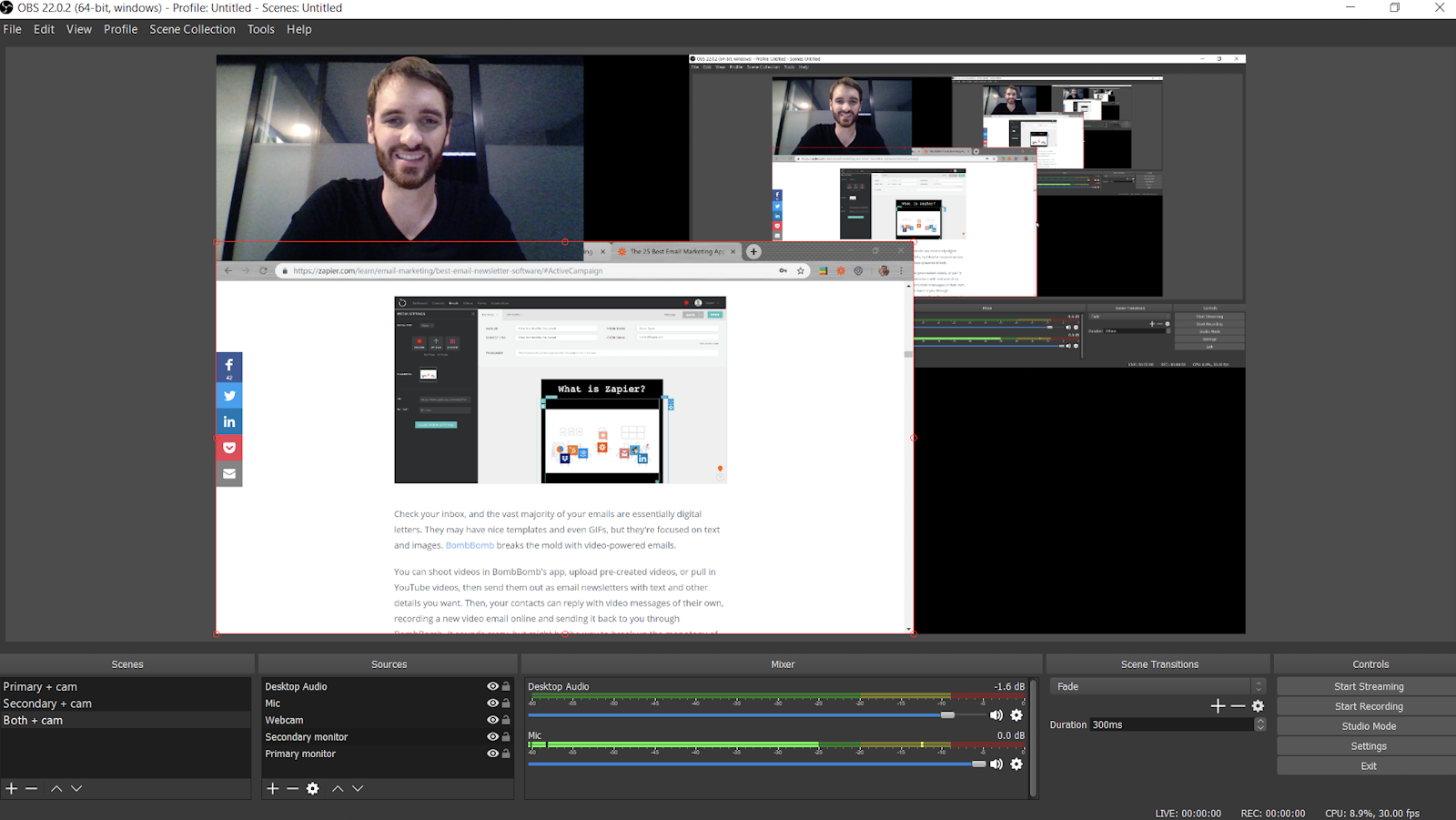
3. Taking Notes:
At NodeSource we take copious amounts of notes. Notes are not everyone’s cup of tea, but from a product perspective, they are invaluable. While our engineers get to focus on thinking through complex architectures, workflows and codebases, a note-taker documents their shared thoughts at every turn.
From a product perspective, engineering meetings are captured in notes almost verbatim. This provides the basis for accurate feature-specs that reflect engineering realties and decisions accurately to prevent expensive misunderstandings later.
And if confusion remains, the aforementioned video recordings are a great way to go over a particularly complex part of the meeting again.
4. Mitigating Context Switching through Slack etiquette
Functioning remote teams are masters in mitigating the effects of context switching. One downside of hosting most of your conversations in Slack or Microsoft Teams is the felt desire to jump into a conversation before the conversation progresses to decisions that are made without your input.
Think of the last time a bug necessitated an architectural choice. A ticket or staff identifies it, flags it on Slack and before you know it, 55 messages involving lead engineers, product managers, the odd helpful samaritan and management drop everything they do for 20 to 30 minutes to identify, diagnose, joke, argue, problem-solve and prioritize. This is too much for any single messaging app.
At NodeSource we unconsciously developed a few practices which we attempted to reflect into a short guide that we modeled into the following acronym for easy recall:
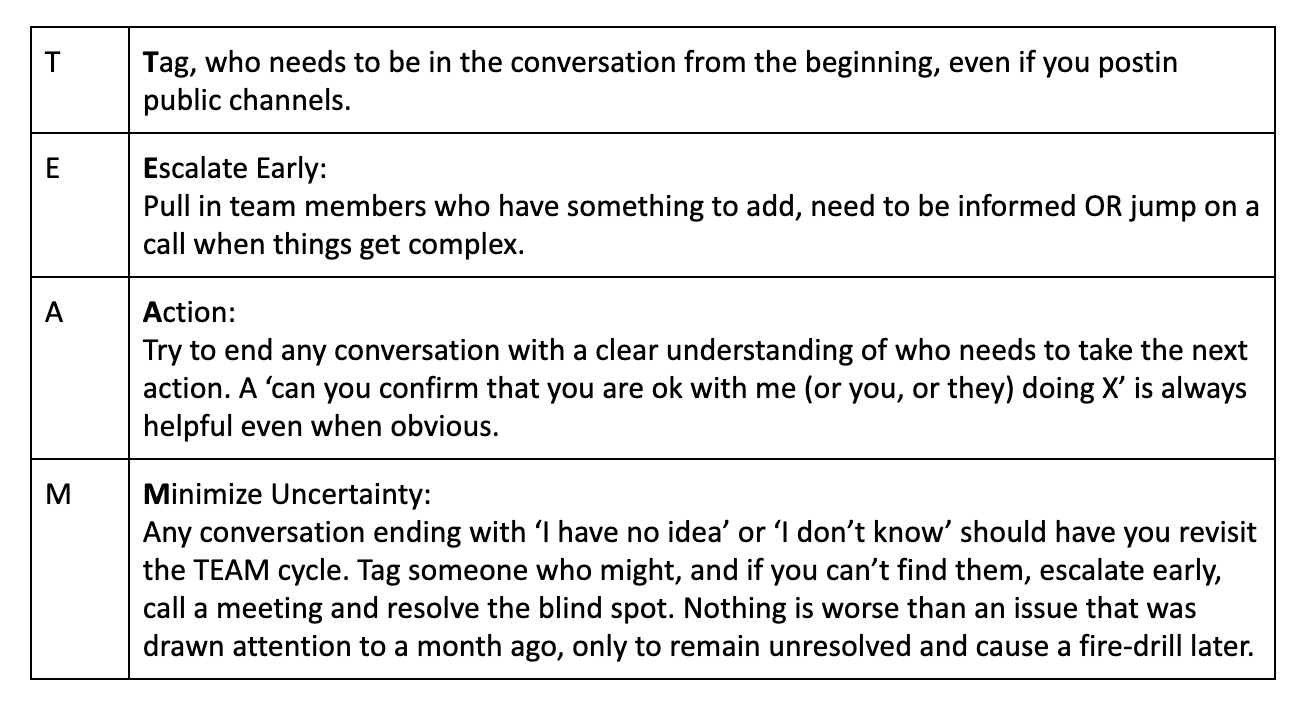
5. Bonding
Bonding in a remote work environment is an activity that must move into the digital age. After all, you can’t grab a beer with your colleagues at the local.
So what remains? Games! We are not joking. At NodeSource we like to play games.
From D&D to Smash Brothers, Mario Cart to JackBox, we aim to set up an online gaming session once every quarter.
For larger teams, where ‘gaming’ is not everyone’s cup of tea, an excellent choice is the Jackbox Party Pack. It’s a quiz-based online gaming experience, specifically designed to see hilarity ensue regardless of whether you have or haven’t heard of the Master Chief.
Each game can host 8 players and an unlimited number of spectators with voting powers and all that’s required is access to a browser window, whether that is on your MacBook or your phone.
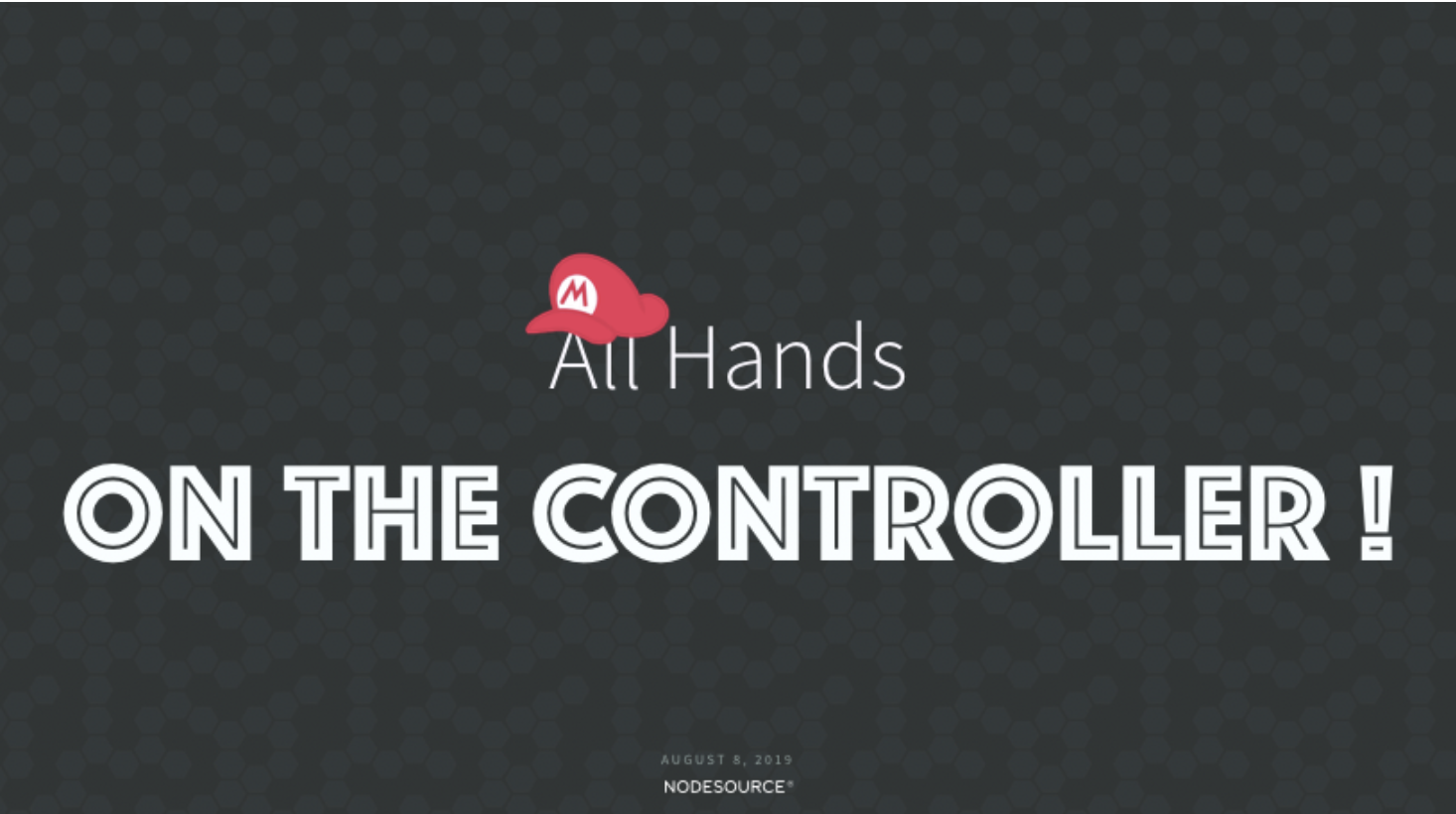
We can help with Node.js
We hope you found these tips useful. At NodeSource we provide Node LTS and Enterprise versions, hardened for scale, performance and secure deployments. For anything regarding Node.js, please feel free to reach out to us on Twitter @NodeSource or visit our website www.NodeSource.com.
Also, please let us know if you have some interesting practices you wish to share.
References
Attention span during lectures: 8 seconds, 10 minutes, or more?
